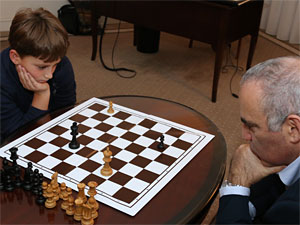


ChessBase 17 - Mega package - Edition 2024
It is the program of choice for anyone who loves the game and wants to know more about it. Start your personal success story with ChessBase and enjoy the game even more.
Yesterday we showed you a puzzle that was fairly easy to solve. It had six pieces on the board, with the white king was on c8. However, moving it to d8 introduced a subtlety that made the study really hard. Here is the solution:

[Event "British Chess Magazine"] [Site "?"] [Date "1922.??.??"] [Round "?"] [White "Joseph, D."] [Black "White to play and win"] [Result "1-0"] [SetUp "1"] [FEN "3K4/kp6/p7/1P6/8/8/7P/8 w - - 0 1"] [PlyCount "25"] [EventDate "1923.??.??"] 1. b6+ $1 (1. h4 $2 axb5 2. h5 b4 3. h6 b3 4. h7 b2 5. h8=Q b1=Q $10) (1. bxa6 $4 b5 2. h4 b4 3. h5 b3 4. h6 b2 5. h7 b1=Q 6. h8=Q Qb8+ $19) 1... Kb8 $1 { Ahhh, the difference to the first position!} (1... Kxb6 2. h4 $18 a5 3. h5 a4 4. h6 a3 5. h7 a2 6. h8=Q $18) 2. h4 a5 3. h5 a4 4. h6 a3 5. h7 a2 6. h8=Q $1 a1=Q {[#]White cannot capture on a1 due to stalemate!} 7. Qg8 $1 ({Not} 7. Qe8 $2 {because after} Qg7 $1 $11 {is a draw.}) 7... Qa2 8. Qe8 $1 ({Again careful: } 8. Qf8 $2 Qa3 {and now} 9. Qe8 {is not possible because of} Qd6+ {and Black wins!}) 8... Qa4 9. Qe5+ Ka8 10. Qh8 $1 $18 {[%cal Gh8g8,Gg8e8,Ge8e5,Ge5h8] With this beautiful manoeuvre White has achieved a winning position – in fact a forced mate:} Qf4 11. Ke7+ Qb8 12. Qa1+ Qa7 13. Qxa7# 1-0
And now to the stories and experiments. Over the years I have given the above two-part puzzle to more than a dozen young chess talents, always dictating the position and the modification (wK on d8, not c8), always forcing them to do it in their heads. I will not name names and give the solving times for players who today are hovering around 2800. Bygones will be bygones. But this year we tried it with chess talents of the very newest generation, and this has to be narrated.

First it happened that in October an extraordinary ten-year-old chess talent visited our office, together with his parents and his younger sister. In a previous report we told you how Vincent Keymer (photo above) had received a two-hour session with a very experienced youth trainer, who was profoundly impressed by his skills and understanding.
At lunch, which consisted of sandwitches and soup served in the ChessBase office, I dictated the first position of my talent test to Vincent. He thought about it for less than two minutes and then gave me the solution. Very easy. Then I told him to move the king to d8 in the initial position. His reaction: "But that does not change... wait a minute: ahh, stalemate on b8!"
Lunch continued, with Vincent chatting with ChessBase people and his parents. "Will you work on the study?" I asked him. "I am working on it," he replied. Some of the ChessBase staff wanted to fetch a chessboard and pieces, but I told them to leave him alone. And then suddenly I said: "See, he solved it – in exactly sixteen minutes." Really? How could I know? "Just look at his face!" There was a big smile of contentment, sufficient for me to be certain. But the others wanted proof, and Vincent dictated the solution accurately, drawing a triangle in the air, and even refuting the tries with 7.Qe8 and 8.Qf8 quite accurately. Sixteen minutes because he had been trying to work out why these moves didn't succeed.

I narrated this experience to ChessBase India editor Priyadarshan Banjan, who looks after a number of very young chess talents himself. He showed it to his fondest charge, Nihal Sarin (photo above), who is just a few months older than Vincent. Nihal solved the position very quickly in his head, even giving the draw variation after 7.Qe8. All this took just a couple of minutes, as this smartphone video, which Priyadarshan started recording after the lad had given the first move. It shows you how quickly he comes up with the correct solution.
Quite stunning, but our colleague investigated further, over dinner. "I calculated the main line," Nihal told him, "and then I remembered a pattern I had studied some two years ago, in a book called 'Endless Endings'. After that the rest was easy."

Priyadarshan found the well-thumbed book in Nihal's "library" – a compilation of chess positions with witty captions. Nihal essentially has the entire book in his head, and when he came to the move 6.h8Q a1Q he remembered the above diagram and the solution given in the book.
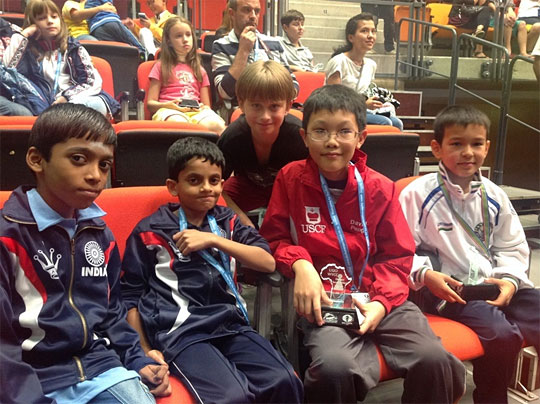
The future of chess: R. Praggnanandhaa R. (India), Nihal Sarin (India), Vincent Keymer (Germany), David Peng (USA) and Nodirbek Abdusattorov (Uzbekistan) at the Youth and Cadets Chess Championships in Porto Carras at the end of October this year
One more for the road? Recently we were visited by Timur Gareev, a Uzbek grandmaster, adventurer and one of the best blindfold simultaneous players in the world.

In our office I gave Timur the two-part study to solve on an empty board.
He got the first part in one minute and ten seconds (I had a stopwatch!) ...
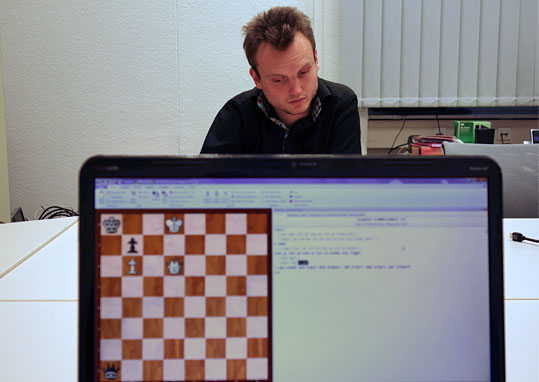
... and struggled over the second part for 12 min 30 seconds
Back to Vincent and to today's Boxing Day puzzle. We reported in October how Garry Kasparov was in Berlin and I had used the opportunity to stage an interesting encounter. At the time I wrote that...
... there is this tradition between Garry and me: once a year I am allowed to ask him to check out some (in my opinion) extraordinary talent, which consists of him looking at games, sometimes analysing personally, for an hour, with my candidate, and then giving me an opinion. I have the greatest respect for that: Garry has spotted a number of world class players before anyone had even heard their names.
I had not dragged anyone to him for quite some time, so I seized the opportunity and took Vincent and his father Christof to the beautiful WestIn Hotel to meet the legendary 13th World Champion. I warned them: he will have very little time – he is on a two-day blitz in the city, guest of the Aspen Institute and the German government, giving interviews to news magazines and TV stations, attending dinner banquets. So a handshake and book signing is what you should accept. Christof was perfectly satisfied: "If Vincent just gets to meet Garry Kasparov that will be a great moment for him, it will be a big motivation in his chess career."
Well, Garry walked into the hotel, accompanied by Aspen aides, spotted us and came over. After greeting the grown-ups he turned to the lad and said: "So, you are Vincent?! Have you brought a chessboard with you?" He had, and Garry invited us all up to his suite in the WestIn.
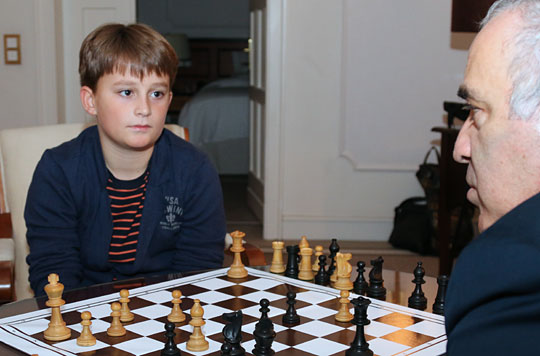
In the above-mentioned report I described how Garry looked at some of Vincent's games...
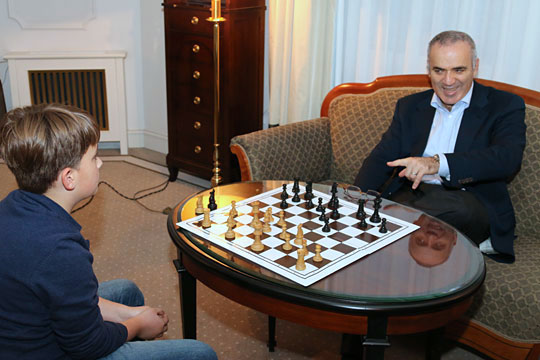
... and gave the lad contructive advice to improve his repertoire and general chess skills.

Then Garry switched to something different: he gave the boy studies to solve. Here is the first:

White to play: the question was: can he win this position?
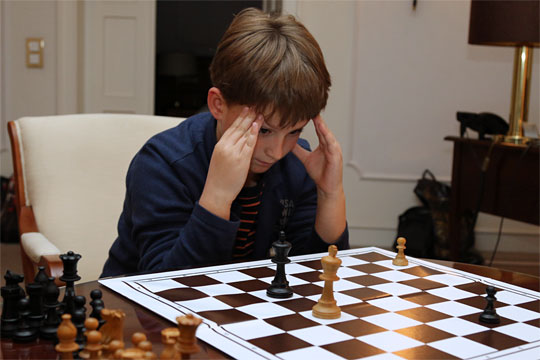
Vincent was supposed to solve the study without moving any pieces – and you, dear readers, are asked to do the same: try to work things out in your head while staring at the above diagram.

Vincent came up with the solution fairly quickly, but Garry was not satisfied with just the key move. "Great, but now find a defence for Black which makes things really difficult for White to win," he said.

The study was tougher than anyone could imagine, and Vincent got a little help from Garry, who after the key defence was found explained some of the geometry involved
We will give you the solution of the above problem tomorrow – in the meantime you should try to solve it without any help from the computer (of course), and directly off the diagram, without moving any pieces. If that does not work then you can use a chess board and pieces. A little hint: it is the second black move that makes the study really tricky – you need to find the defence and White's path to victory. Time yourself – tomorrow we will tell you how some strong GMs fared with the study.
As a special bonus for the puzzle week we bring you twin problems sent to us by our most faithful friend:
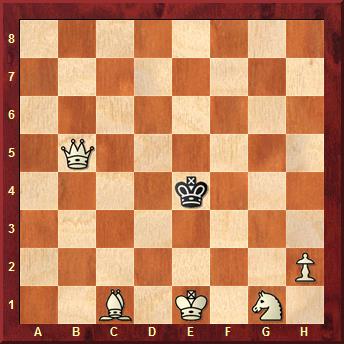
White to play and mate in two
This problem is fun, and not too difficult to solve. But there is more to it than the mate in two. It is the first in a series of "twins", which you can try to find for yourself. Pal explained the concept:
Twin problems are rare in direct mates, it needs skill and luck to find them. In a perfect twin there is only one change: you move one piece to get a new problem with different solution. You should publish these problems, just one on each day, and ask your readers not just to solve them but to try and figure out which will be the next one.
So, dear reader, you are asked to solve the above problem and then construct a new position by moving a single piece to a different square. The new problem is again a mate in two. Over the week there will be five twin problems, each derived from the previous one by changing a single piece. Have fun.